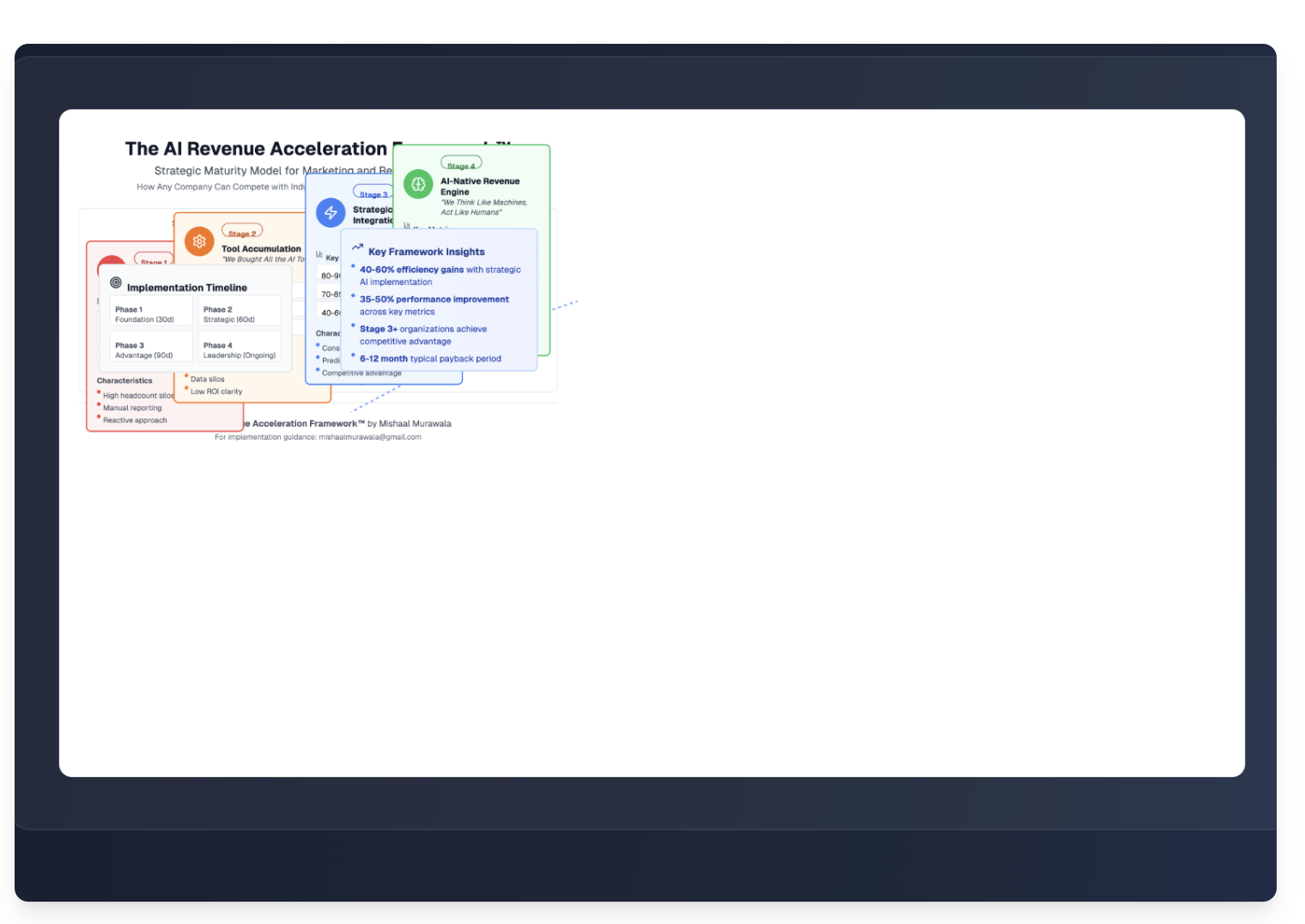The AI Revenue Acceleration Framework
Strategic Maturity Model
Every executive asks the same question: "Where do we stand with AI, and how do we get ahead?" This framework shows you exactly where your company is today and the fastest path to AI-native revenue operations.
The Four Stages of AI Revenue Maturity
Like the Gartner maturity models that guide technology decisions, this framework maps the inevitable journey every company makes from manual operations to AI-native revenue engines.

40-60%
Efficiency gains with strategic AI implementation
35-50%
Performance improvement across key metrics
Stage 3+
Organizations achieve competitive advantage
6-12
Month typical payback period
Stage 1: The Reactive Scramble
Foundation (30d)
Executive Reality:
"We're constantly putting out fires. Every week there's a new crisis—leads aren't converting, sales and marketing aren't aligned, and we're making decisions based on gut feeling because our data is scattered across fifteen different tools."
— CEO, $50M SaaS Company
Characteristics:
- • High headcount silos between teams
- • Manual reporting and data compilation
- • Reactive approach to market changes
- • Decision-making based on incomplete information
- • Constant firefighting mode
The Hidden Cost:
• 60% of executive time spent on status meetings
• 40% revenue leakage from misaligned teams
• 3-6 month lag in market response time
• Burnout rates above 70% in GTM teams
Stage 2: The Tool Accumulation Trap
Strategic (60d)
Executive Reality:
"We bought all the AI tools—Salesforce Einstein, HubSpot AI, Gong, Chorus, you name it. We're spending $200K+ per month on software, but somehow we're still manually pulling reports and our teams are more confused than ever."
— CMO, $100M Technology Company
The Expensive Mistake:
- • Data silos across disconnected tools
- • Low ROI clarity on AI investments
- • Tool fatigue and adoption resistance
- • Increased complexity without intelligence
- • Higher costs, same problems
Why This Fails:
• Tools don't create strategy
• No unified intelligence layer
• Human bottlenecks remain
• Data stays fragmented
• Decision latency increases
Stage 3: Strategic Integration Breakthrough
Advantage (90d)
Executive Reality:
"For the first time in years, we're ahead of the market instead of reacting to it. Our AI layer sees patterns we never could, and our teams are making decisions with confidence. We've cut our GTM costs by 35% while increasing pipeline quality by 60%."
— CRO, $250M Enterprise Software
The Transformation:
- • Unified intelligence across all systems
- • Predictive insights drive decisions
- • Automated optimization protocols
- • Cross-functional alignment achieved
- • Competitive advantage established
Business Impact:
• 40-60% efficiency gains realized
• 35-50% performance improvement
• Decision latency reduced by 80%
• Market response time under 48 hours
• Executive time freed for strategy
Stage 4: AI-Native Revenue Engine
Leadership (Ongoing)
Executive Reality:
"We think like machines, act like humans. Our revenue engine runs itself—identifying opportunities, optimizing campaigns, and scaling what works while our team focuses on strategy and relationships. We're not just ahead of competitors; we're playing a different game entirely."
— CEO, $500M Market Leader
The Future State:
- • Autonomous revenue optimization
- • Self-healing GTM systems
- • Predictive market positioning
- • Continuous learning and adaptation
- • Human creativity amplified by AI
Market Position:
• Category leadership established
• Sustainable competitive moats
• Premium pricing power
• Talent magnet for top performers
• Industry benchmark status
The Acceleration Advantage
Most companies take 3-5 years to reach Stage 3. With the GTM Intelligence Layer, you can accelerate this journey to 90 days.
Traditional Path
Stage 1 → Stage 212-18 months
Stage 2 → Stage 318-24 months
Stage 3 → Stage 412-18 months
Total Time3-5 Years
Accelerated Path
Phase 1: Foundation30 days
Phase 2: Strategic60 days
Phase 3: Advantage90 days
Total Time90 Days
Acceleration Factor:
12-20x faster than traditional approach